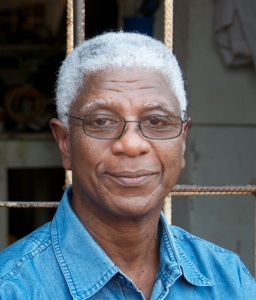(See citation instructions at the bottom of this page)
My idea initially was that I was doing sculpture – sculpture that is so free that you can change its form in any way. You can contract it, you can expand it, you can shape it in any way.
The work is now a marriage between painting and sculpture.
I don’t believe in artworks being things that are fixed.
If you leave your country you develop a kind of a nomadic mentality, and a mentality which wants you to be roaming about. If I had lived in Ghana, my mind wouldn’t have roamed, therefore I wouldn’t have expanded my experiences. Or I would have been too comfortable.
Geography and all those things don't count very much in my scheme of things. I think the most important thing is that one is able to reach or communicate. I think people want to use geography to see whether they can understand you, or that kind of thing. That’s why I’m sure art historians and anthropologists would be classifying people by geography, or by ethnic group or such things.
One thing that I have grown into is working with things which have been used before -- things which link people together. I don’t know about DNA, but if you touch something, you leave a charge on it and anybody else touching it connects with you in a way -- and the fact that anything that has been used by humans has a history, so those properties I think help whatever I do to gain some meaning.
With the bottle caps now I don’t do any drawings. You might be making yourself a slave to an idea. But I want to enjoy the freedom of shifting around things
Initially my idea wasn’t that I was doing something close to painting or related to painting. As time went on, I saw that there were elements that I was ignoring like colors of the various caps - the red, the black the white, yellows were all there. So I started being conscious of them as well.
From: Anatsui at Work: Eight Short Films
I’m an artist who is given to working with materials in my environment. I think all the things that were taught in art school I set about subverting them. Like the materials that we used in school, I knew that they were strange. Using plaster of Paris and such things which are imported -- you know, they don’t make plaster in Ghana. So it means that you do art with whatever is around you. (From Materials from the Environment)
My work has kind of tried to revolve around the history of the continent of Africa. These bottle tops have served as a link between my continent, Africa, and Europe. Drink was one of the prime objects that they brought. (From Materials from the Environment)
[Speaking of his “Fresh and Fading Memories” at Palazzo
Fortuny] When you look at it, it gives you some idea of patchwork, which is one of the ideas that I am exploring now with my bottle cap series -- because as I child I saw people go to the tailors and ask them to join all the pieces for them into one patchwork. It is not high fashion to wear such things, but it has associations that have a lot to do with poverty and frugality. (From The Nomadic Aesthetic)
[I am interested in textile because it is] Always in motion. Anytime you touch something, there is bound to be a change. The idea of a sheet that you can shape and reshape. It can be on the floor, it can be up on the ceiling, it can be up on the wall, all that fluidity is behind the concept. (From The Nomadic Aesthetic)
Colleagues Quotes from: Fold Crumple Crush
Ola Oloidi, Professor of Arts, University of Nigeria, Nsukka
He had this restless attitude to research, experimentation. And right from the beginning you could see the anti-conventional approach to art creation. Within a few years, El’s stylistic philosophy, his formalistic (not just tendencies…realities) penetrated other sections of the department. And within a few years it became very difficult to know the difference between painting, ceramics, sculpture, even graphics.
In Europe and in America the artistic language was already there. But in Nigeria it was not there. And it was through somebody like El that that new art culture started being appreciated -- and that is a fact! More than any artist in Nigeria, it was El who not only embodied but championed -- without knowing that he was championing it -- these new radical, post-modernist affirmations in Nigeria today.
Onyishi Uchechukwu Studio Manager for Anatsui
I started working with him as an undergraduate student, and El advised us to use cheap mediums – because when you are using cheap mediums you are freer. Unlike when you use material that is expensive like gold, it tends to restrict the size of the work and you tend to economize. But when you use cheap medium, you are freer and you express yourself better, and the size of the work will sometimes become intimidating.
Robert Storr, Curator, Venice Biennale 2007
This is all the detritus of everyday life in Africa. This is the recycling of industrial production into something that is completely transcendental made out of junk. This is not pop art, but it is an aesthetic that reaches back into a whole series of things in the postwar period -- but it has a kind of exaltation I have not seen before.
To cite from this page, follow this model:
El Anatsui, from Fold Crumple Crush: the Art of El Anatsui, a film by Susan Vogel, 2011. Online transcript viewed at susan-vogel.com/Anatsui [the date you visited the site].

